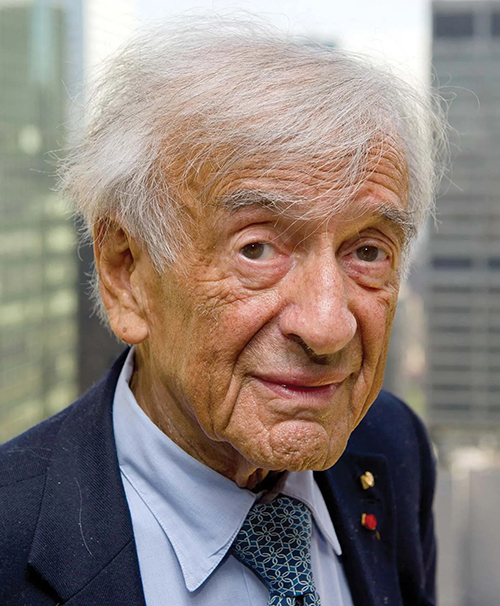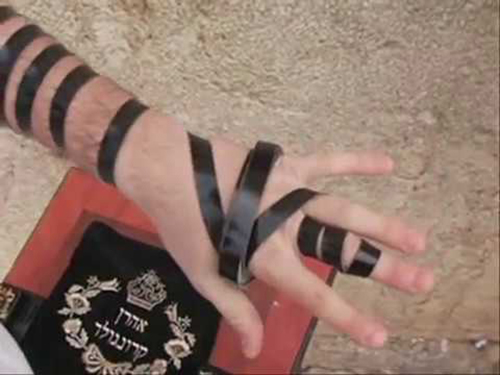|
Getting your Trinity Audio player ready...
|
Tefillin in Auschwitz—and elsewhere
By: Avraham Rosen
In February 2009 (the first day of the month of Adar), I was invited to lecture at Florida Atlantic University on a topic that I was researching, “A New Index to Time: Calendars and the Holocaust.”
In hiding, in ghettos, even in concentration camps, such calendars were fashioned to equip Jews with the information necessary to observe the Sabbath and holidays, as well as yahrzeits and even fast days, in whatever form was possible. Under oppressive conditions, producing calendars of this sort took an extraordinary act of resolve. Yet some 30 calendars of this kind existed. I was working toward a book on the topic, and my lecture at FAU on that Wednesday afternoon was one of my first attempts at speaking about this precious cache of artifacts and sharing the stories behind them.
As I recall, the presentation went well enough. But during the question and answer session that followed, a gentleman stood up, identified himself as a survivor of Auschwitz, and stated that making calendars of this sort in Auschwitz was impossible. Why? Because, he continued, a Jewish prisoner of this infamous concentration camp had time and energy only for working, eating and sleeping. Conditions were harsh beyond belief, and it was all one could do, he said, to simply survive. To even think of doing something other than what was basic was out of the question. He spoke firmly and definitively.

Somehow I had not expected this challenge, and felt intimidated by the authority of his experience. I fell back on the evidence I had accumulated. Other survivors in the audience also weighed in, saying that despite the oppression, some people could do more than just survive. I was grateful for their assurance, but as the afternoon program wound down, I was uncertain about how to make sense of the Auschwitz survivor’s assertion.
Having the opportunity to meet with my teacher, Elie Wiesel, in his New York study a few weeks later, I described for him what had happened during my FAU lecture, and asked for his advice. This was typical. In our regular phone conversations and meetings, I would ask his advice about questions that came up in my research and writing, but also about questions that had to do with life: holiday observance and prayer, children, the untimely death of dear friends—and much more.1
Professor Wiesel listened to me and replied: “What he said is true. But his truth was not my truth. I put on tefillin in Auschwitz every morning. I probably shouldn’t have done it. But I did.”2
The details of how Professor Wiesel managed to lay tefillin in such dangerous circumstances surface in his writings and interviews. He wrote in a 1982 article:
I don’t know how, but someone had managed to smuggle in a pair of tefillin by bribing a kapo with dozens of bread and margarine rations. I only know that every morning many of us rose before the call-up to perform this mitzvah. Jewish law would not have required it under the circumstances. One is not obligated to sacrifice his life for the sake of donning tefillin. And yet, Jews who did not know each other, who perhaps did not even speak the same language, met each morning at dawn, exposed themselves to nameless dangers for the sake of not interrupting a millennia-old tradition.
I do not understand it. I will never understand whence they derived so much courage and marshaled so much self-denial, even while the world was forsaking them and surrendered them to death.3
Professor Wiesel set down a similar description in his 1995 autobiography, All Rivers Run to the Sea, emphasizing the meaning his laying tefillin would have for his father:
In the morning my father and I would rise before the general wake-up call and go to a nearby block where someone had traded a dozen rations of bread for a pair of phylacteries (tefillin). We would strap them onto our left arm and forehead, quietly recite the ritual blessings, and then pass them on to the next person. A dozen prisoners thereby sacrificed their sleep, and sometimes their rations of bread or coffee, to perform the mitzvah, the commandment to wear the tefillin. Yes, we practiced religion even in a death camp. I said my prayers every day. On Saturday I hummed Shabbat songs at work, in part no doubt, to please my father, to show him I was determined to remain a Jew even in the accursed kingdom.4
Professor Wiesel’s commitment to honor this commandment, even under grueling circumstances, preceded the ordeal of the camps. In the early pages of his memoir Night, he makes a reference to laying tefillin as he conducts his usual prayers the morning before the deportations of Sighet’s Jews commence.
By eight o’clock in the morning, weariness had settled into our veins, our limbs, our brains, like molten lead. I was in the midst of prayer when suddenly there was shouting in the streets. I quickly unwound my phylacteries and ran to the window. Hungarian police had entered the ghetto and were yelling in the street nearby.5

This is one of several scenes in which the deepening crisis interrupts normal daily activity. Yet we see how Professor Wiesel continued with daily rituals, including the standard practice of donning tefillin during morning prayers, until the last moments of regular community life.
Moreover, the uprooting of the community did not end such commitments, for as Professor Wiesel noted in a 1970 lecture, he had made sure to take tefillin with him at the time of deportation:
We Hungarian Jews arrived at Auschwitz in 1944. I was young and innocent. In my suitcase I had tefillin, not even a tallis yet. . . . I had only tefillin, a siddur [prayerbook], and a few other seforim [holy books].6
Once the ordeal of the war had come to an end, his commitment to tefillin was still front and center. Indeed, Professor Wiesel’s diary, begun in June 1945, while recuperating at a “splendid chateau in Écouis [France],” refers to laying tefillin in the diary’s very first entry:
I went to see the director in his office and shyly asked for a pen and paper. I began a private journal: “After the war, by the grace of G‑d, blessed be His name, here I am in France. Far away. Alone. This morning I put on my own tefillin for the first time in a long while.”7
What are tefillin (also known as phylacteries)?8 Two leather boxes with straps that Jewish men traditionally put on (or “lay”) on weekdays, as commanded by the Torah and elaborated on by the sages. The boxes contain parchment on which are written, by a skilled and pious scribe, the four passages from the Torah that refer to tefillin.9 The straps are used to affix the boxes to one’s upper arm (opposite the heart) and on one’s head, above the scalp (close to the brain). The proximity to the heart and mind are understood to be a way to link the emotions with the intellect, enabling them to act in concert. The arm straps extend to the hand, which symbolizes the realm of action, and which is also to be harmonized with thought and emotion.
Tefillin carries further associations. The passages enclosed within the tefillin contain the Shema (“Hear, O Israel: G‑d is our L‑rd, G‑d is one”), Judaism’s central prayer invoking belief in G‑d’s oneness and submission to His will. Other passages in the tefillin emphasize the miraculous exodus from Egypt (and the bondage to which the Jews were subjected there), in order to become uncompromising servants of G‑d. Because the passages are not only read but are worn on one’s body, they offer a unique form of tactile memory, a daily discipline of kinetically recollecting key tenets of Jewish faith and experience—a recollecting that could take place even, or perhaps especially, in Auschwitz.
Professor Wiesel was one of a number of Jews whose commitment to the commandment of tefillin in the camps was extraordinary. Written and oral accounts tell of how men performed the mitzvah of tefillin in a variety of labor, concentration and even death camps: rising well before dawn and standing in long lines; wearing them only briefly, so that others could also have the opportunity; clandestinely putting them on while marching in labor squads; paying with food rations for the opportunity to use or acquire the tefillin; devising strategies and hideouts so that the enemy would not discover the forbidden objects. Stories are told of the miracles involved in procuring, preserving and wearing the tefillin, and of attributing one’s survival to the performance of this specific mitzvah.
There are also the sober reports of those tortured or murdered when caught wearing tefillin. Others tell with anguish of the mounds of confiscated tefillin, a sign of the enemy’s ruthless assault on Jewish life and an improvised memorial to the Jews who, on the threat of death, were not allowed to touch or even approach the sacred but contraband articles.10
Despite the risks and difficulties of putting on tefillin during the Holocaust, the demand was sometimes greater than the supply. In one labor camp, for instance, a single pair of tefillin had to serve some 500 men, so that the head and hand tefillin, usually donned simultaneously, were divided up so that everyone could have a chance. Indeed, because of the cruel circumstances, rabbis in certain cases determined that the usual way of carrying out the mitzvah could be modified in order to make performing the mitzvah possible.
And even in those cases where tefillin were nowhere to be found, inmates sometimes devised ways to maintain a connection with daily practice. Filip Muller reports that a Polish Jew by the name of Fischel, head of a Sonderkommando unit in Auschwitz, did not possess tefillin, but “mimed the ritual” of putting them on before prayers. Eventually he acquired a pair and used them daily. His dedication to prayer and ritual in that sordid world was such that he inspired other Sonderkommando members to join him.11
In a sense, performance of the mitzvah spoke for itself. But a few rabbis, themselves camp survivors, have tried to explain the significance of carrying out this particular mitzvah under such atrocious conditions. Rabbi Tzvi Meisels, whose imprisonment in Auschwitz-Birkenau overlapped with that of Professor Wiesel, surmised that there was no way to understand the events one was being compelled to live through—no explanation as to why the Jews were being made to suffer so profoundly—that could be drawn on to strengthen one’s faith. Performing the mitzvah of tefillin bespoke acceptance in spite of such lack of understanding, and thus “fortified broken hearts, so that we would not spend a moment without perfect faith, even when we had no understanding.”12
Rabbi Yehoshua Aronson accounted for the significance of this mitzvah in the camps differently. The Torah passages in the tefillin refer to G‑d taking the children of Israel out of the slavery of ancient Egypt. Hence, tefillin were the symbol of that freedom. The tefillin straps also bear several ritually prescribed knots—knots which, in the overwhelmingly difficult circumstances of the camps, served as reminders, according to Rabbi Aronson, of G‑d’s enduring love for his people, His being bound or knotted to them.13
In many of his writings, Professor Wiesel links tefillin both to maintaining Jewish identity and to transforming it. In his 1970 collection of essays, One Generation After, for instance, he tells of Shmukler, a beggar of unknown origin who was thought to be mad. Professor Wiesel one day surprised him in a Sighet synagogue wearing tefillin; adorned in this traditional manner, Shmukler appeared to him “a different man.”14
The transformational quality of tefillin surfaces again in a beautiful episode recounted in Somewhere a Master, Professor Wiesel’s second volume chronicling the inner history of the chassidic movement. Reb Yechiel Michel of Zlotchov, a well-known early chassidic master, had a son, Wolfe, who as a youngster was not given to following in the holy ways of his father. The son’s “behavior left much to be desired. He wasted days and nights with unsuitable friends doing unsuitable things.” There seemed to be no end of this aberrant behavior, even up to the day of his son’s bar mitzvah—the day on which a boy is first obliged to fulfill the precept of tefillin and, as in this case, receives them as a gift.
Before Reb Yechiel Michel gave his son the tefillin, “he inspected them with great care. He read the two parchments and replaced them in their square boxes. And suddenly he began to weep. Tears began rolling down his cheeks into the boxes with the tefillin. That was the turning point for Wolfe.”15 The father’s tears and the occasion of receiving tefillin combined to transform the undisciplined boy into a master-in-the-making.
Professor Wiesel recounts a second moving tefillin episode involving the same chassidic master, Reb Yechiel Michel, who in this case helped his protégé, Naphtali of Ropshitz, “put on tefillin for the first time, remarking: ‘I have just tied his soul up there; the knot will be a lasting one.’”16
With these vignettes Professor Wiesel shows the meaning behind the tefillin that were so much a fixture in his own life.




